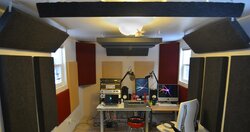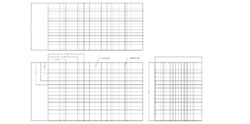garymacf
Registered
Thread Starter
- Joined
- Mar 14, 2020
- Messages
- 5
More
- Preamp, Processor or Receiver
- Avalon M-5
- Streaming Subscriptions
- Dayton UMM-6
Hello. I’m an audio book narrator who has recently moved out of a cramped booth situation and into a a larger recording space, a small building separate from the house. The space originally didn’t sound very good, with a booming, echoey quality. I’ve worked on the acoustics, and recently used REW to measure the room. I’m hoping for some assistance in interpreting the results of the .mdat file I’ve included.
The space is 15 ft. 4” long x 9 ft. 4” wide x 7 ft. 7” high (or 112” x 184” x 91.5”). I’ve got a mixture of 12 16”x48”x3” deep traps filled with Roxul; 5 24”x48” 2-inch deep ATS panels, and two triangular ATS bass traps on the front wall. Three of the 16”x48” traps are hung from the ceiling as a cloud above the mic position. A piece of 6 ft. x 6 ft. carpeting is on the tiled floor.
For testing I used a Dayton EMM-6 with its calibration file, and for an interface I used a Steinberg UR28M for which I produced a loopback calibration file. I did tests at 7 reference mic positions, and the distance from the front wall, side walls, etc. are noted on each test in the REW file. For playing the sweep I used Yamaha HS50M studio monitors on temporary 15” stands above the desk.
The room response while I’m narrating is more important to me than how the room sounds during playback. I’ve read (and re-read) the Room Measuring Primer posted recently by DanDan. That was very helpful. But REW produces a lot of information, and I’m not exactly clear on what I’m looking at. Overall I want to gain a better understanding of how the entire room is behaving, and what I might need to do next.
Thank you in advance for any suggestions for next steps.
The space is 15 ft. 4” long x 9 ft. 4” wide x 7 ft. 7” high (or 112” x 184” x 91.5”). I’ve got a mixture of 12 16”x48”x3” deep traps filled with Roxul; 5 24”x48” 2-inch deep ATS panels, and two triangular ATS bass traps on the front wall. Three of the 16”x48” traps are hung from the ceiling as a cloud above the mic position. A piece of 6 ft. x 6 ft. carpeting is on the tiled floor.
For testing I used a Dayton EMM-6 with its calibration file, and for an interface I used a Steinberg UR28M for which I produced a loopback calibration file. I did tests at 7 reference mic positions, and the distance from the front wall, side walls, etc. are noted on each test in the REW file. For playing the sweep I used Yamaha HS50M studio monitors on temporary 15” stands above the desk.
The room response while I’m narrating is more important to me than how the room sounds during playback. I’ve read (and re-read) the Room Measuring Primer posted recently by DanDan. That was very helpful. But REW produces a lot of information, and I’m not exactly clear on what I’m looking at. Overall I want to gain a better understanding of how the entire room is behaving, and what I might need to do next.
Thank you in advance for any suggestions for next steps.












